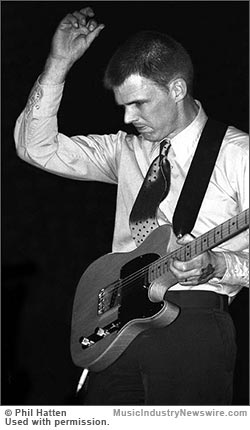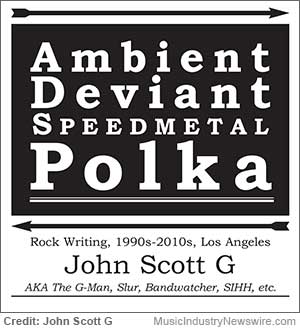BOOK SERIAL – Ambient Deviant Speedmetal Polka Chapter 6 – Hiding in Plain Sight: Rob Kendt, the Man Behind Millhouse
MuseWire BOOK SERIAL – Ambient Deviant Speedmetal Polka: Chapter SIX – Hiding in Plain Sight: Rob Kendt, the Man Behind Millhouse — Songwriters can succeed in more than one style of music but artists tend to do better by sticking to one easily-identifiable sound. So what happens when a multi-genre songwriter is the leader of a group?
 Okay, so you’re in a band. Fun! Wild! Cool! It’s an experience that can be magical and marvelous. Except, you know, when it’s mundane and malevolent and soul-sucking and financially disastrous. But for now let’s accentuate the positive. Being in a group means someone’s got your back. Ya got mates! Ya got friends! No longer is it just “you against the world.” Now you’re not alone, you’re part of a team!
Okay, so you’re in a band. Fun! Wild! Cool! It’s an experience that can be magical and marvelous. Except, you know, when it’s mundane and malevolent and soul-sucking and financially disastrous. But for now let’s accentuate the positive. Being in a group means someone’s got your back. Ya got mates! Ya got friends! No longer is it just “you against the world.” Now you’re not alone, you’re part of a team!
Plus, it’s a team armed with powerful amplification, electro-acoustic sound generators, and a whole big bouncy batch of chords ‘n’ notes ‘n’ such-like. Very awesome.
Being in a band can give you a sense of the fuzzies. A warm and comfy feeling. Perhaps like a family. Although, considering what we know about most musicians’ families, it’s probably way better to talk about the group. There’s a camaraderie that can be exciting, supportive, and joyous as you experience sharing and caring and moving heavy equipment and attending never-ending rehearsals in dank dark places and coming home reeking of cigarette smoke and stale beer.
And then there’s the great conversations:
“Shit. Busted the high E string.”
“Again? Stop using nines, man.”
“But it’s part of my sound.”
“You gotta go up to tens, man.”
Perhaps only guitarists will fully appreciate that conversation, but that’s part of the point. Being a musician means you can talk using arcane phrases and minutia and argot and jargon and acronyms almost anytime you want. The public isn’t involved at all. You’re a couple of compatriots discussing the tools of their trade, working out how best to be armed and dangerous for the forays into The Battle That Is Called The Club Booking.
(All right, here’s the cheat sheet for non-guitarists: The lower the number of a guitar string, the thinner it is and thus easier to snap.)
Tunage
With all your amps and mics and cables and assorted gear, plus the PA system in a club, you guys can make a hell of a lot of noise. And when you direct it properly, when everybody is moving along the same path to really deliver the song, then the waves of sound can take an audience on a ride that is emotional, spiritual, and dancealicious. Or, dare I say this: hip, hep, wild, and with-it.
So maybe you start out playing a tune everybody knows. “Louie Louie,” perhaps, or “Twist and Shout” or something that’s iconic in your genre. If it all seems to click, and your goal is to play original music instead of being a cover band or a tribute band, there’s one big question you have to face:
“Hey, what are we gonna play?”
“I’ve got a tune,” one guy says, and if the entire band goes along with it, you end up adding that song to your Set List, those ten or twelve numbers you’ll be performing at the club, the dance, the party, the wedding reception, the battle of the bands, and so forth.
“I’ve got another one,” says the guy. And the band buys into it.” And here’s another one,” he says. And it’s also pretty cool. “And here’s this one,” he says, and so on until it’s clear the band has their Lennon/McCartney, their Cole Porter, their Jagger/Richards, their Joni Mitchell, their Irving Berlin. Well, if they’re incredibly lucky.
Soundings
Usually, a band forms its Sound and basically sticks with it. Most groups do not have the stylistic ingenuity of The Beatles, although even the Fab Four kept their sound reasonably consistent through the first albums, and their songs tended to have a stylistic homogeneity within each album up until “Sgt. Pepper”).
 Some bands thrash through their numbers; others may play with ethereal togetherness. Either approach can work. Look up a live performance by any classic punk band (type “CBGB live” into YouTube) and you’ll see how even riotous cacophony can become the sonic violence of poetry). Or attend a solo recital by Keith Jarrett and you can be part of a hushed and worshipful throng.
Some bands thrash through their numbers; others may play with ethereal togetherness. Either approach can work. Look up a live performance by any classic punk band (type “CBGB live” into YouTube) and you’ll see how even riotous cacophony can become the sonic violence of poetry). Or attend a solo recital by Keith Jarrett and you can be part of a hushed and worshipful throng.
Usually, a band has to establish a fan base before stylistic diversification can take place. This means that the strength of a terrific songwriter can be a new band’s biggest weakness. After all, how do you attract, hold, and build an audience if you’re all over the map?
There’s a reason why lots of artists enjoy long careers doing variations of the same songs: one point of view, one genre, one style of presentation. Only a few artists excel in various styles, formats, and genres. Consider: what makes it easier to advertise, easier to publicize, and easier to get gigs? Being in a band with just one style, a band where you only have to name one genre.
Millhouse
Which brings us to the late great Millhouse, a band that consistently delivered more than anyone had any right to expect. When they appeared on a bill with rock acts, they could rock. But on a bill with acoustic acts, they could play softly. Quite apart from that, each of their sets would include songs that moved listeners in a multitude of ways.
They were, indeed, a band that could rawk. Mark Baker could pulverize or purr on drums, while Andy Dadekian would use his bass lines to seduce unwary listeners. These two guys grooved, and that meant that the audience grooved. It was a mutually rewarding arrangement.
On lead guitar, David Ellis would provide subtle textures behind the melodies, then zoom into overdrive on his sparkling solos. He could play like a blues-rocker, a jazzy chord master, a country cat, or various combinations. Whatever the style, Ellis gave your ears a treat.
Then there was Rob Kendt, creator of the aforementioned melodies as well as the beautiful and sometimes humorous lyrics. Strumming his amplified acoustic guitar and standing front and center, Kendt delivered vocals that were strong and clear, his voice deftly cutting through the normally muddy club sound systems.
Songs
This is where Millhouse took people on a different kind of ride. One song soft ‘n’ sweet, the next a powerhouse. Then one that would make you want to pull on some cowboy boots. And then they would push the beat around again. You’d get rock, dance, folk, jazz, and country styles, all in the same set.
But that wasn’t the whole picture. Kendt’s songs went way beyond the normal definition of popular music. They existed on a totally different plane of existence. Why? Because they were lovely works of literature, wonderfully constructed short stories that you might expect to discover in The New Yorker.
With Kendt’s prose and poetry and melody and story and comedy and tragedy you would be lifted above the club scene to a place where mind and body melded. Thanks to him, Millhouse combined rock with pop, country, and cabaret. You’d get: slam-bang excitement plus shit-kicking twangtown tunes plus off-kilter drunken poetry readings plus some get-down party-time fun. I loved it! But this approach was too much for an unsigned band. You’d tell people about Millhouse and watch the puzzlement creep into their eyes. “But what are they like?” And if you said “Like going from one radio station to the next to the next to the next and then back again” you’d discover that this appealed to one out of a thousand people. And like me, that one person had very strange musical tastes.
So, what happened to Millhouse? Well, there was a change from Dadekian to Steve Harris on bass. But the proverbial writing was on the axiomatic dressing room wall and the band broke up. Harris plays with jazz bands in Long Beach, Baker is in an instrumental band called Corksniffer based out of Rocklin, CA, Ellis teaches guitar at McCabe’s, and Dadekian edits film trailers.
Kendt is associate editor of American Theatre magazine and a contributor to The New York Times, The Los Angeles Times, Variety, Newsday, Village Voice, Time Out NY, The Guardian, and The San Francisco Chronicle. And yes, he still writes music: a couple of solo albums have been released and he’s working on writing musicals. A few aspects of all this seem to make sense in some sort of Millhousian way.
• “Ambient Deviant Speedmetal Polka” … to be continued next chapter. You can subscribe to John’s articles and column via RSS (click this link), or read more from JSG here.
Excerpt of book serial is Copr. © 2012 by John Scott G – all commercial and reprint rights reserved. Originally published on MusicIndustryNewswire-dot-com before the site was re-branded in March 2015 as MuseWire.com, a publication of Neotrope®. Photo by Phil Hatten. Used by permission.


